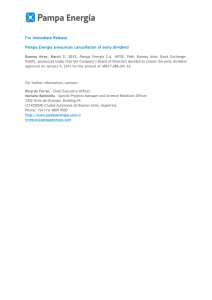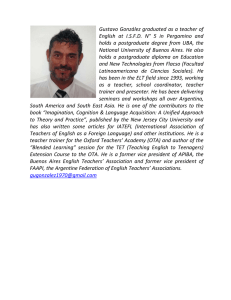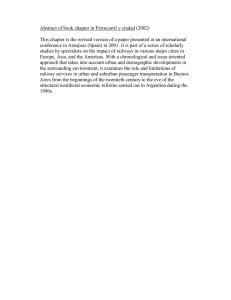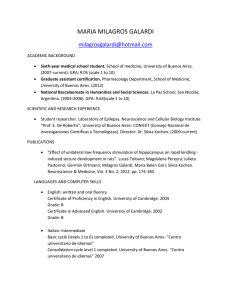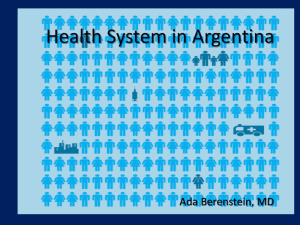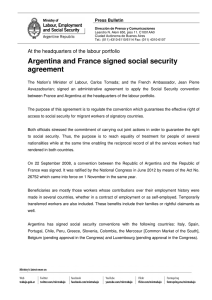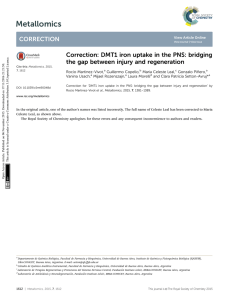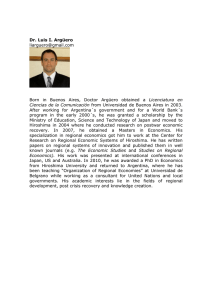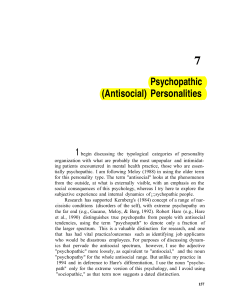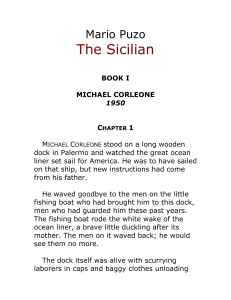Ricardo Piglia`s Blanco nocturno (2010): A Paranoid History of
Anuncio
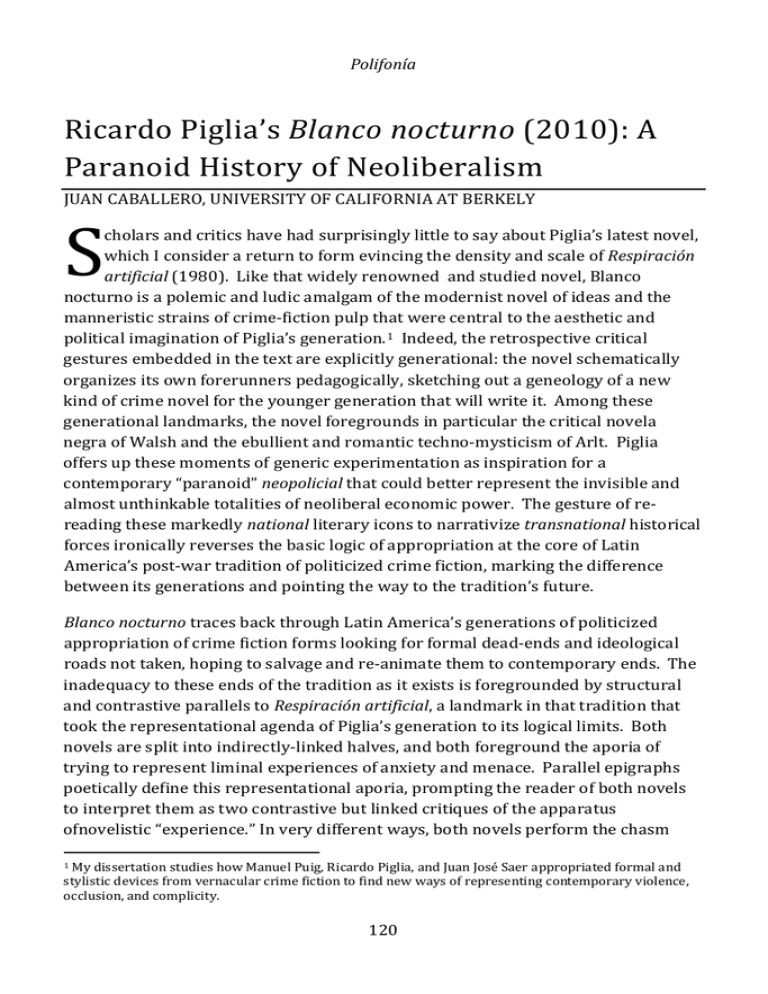
Polifonía Ricardo Piglia’s Blanco nocturno (2010): A Paranoid History of Neoliberalism JUAN CABALLERO, UNIVERSITY OF CALIFORNIA AT BERKELY S cholars and critics have had surprisingly little to say about Piglia’s latest novel, which I consider a return to form evincing the density and scale of Respiración artificial (1980). Like that widely renowned and studied novel, Blanco nocturno is a polemic and ludic amalgam of the modernist novel of ideas and the manneristic strains of crime-fiction pulp that were central to the aesthetic and political imagination of Piglia’s generation. 1 Indeed, the retrospective critical gestures embedded in the text are explicitly generational: the novel schematically organizes its own forerunners pedagogically, sketching out a geneology of a new kind of crime novel for the younger generation that will write it. Among these generational landmarks, the novel foregrounds in particular the critical novela negra of Walsh and the ebullient and romantic techno-mysticism of Arlt. Piglia offers up these moments of generic experimentation as inspiration for a contemporary “paranoid” neopolicial that could better represent the invisible and almost unthinkable totalities of neoliberal economic power. The gesture of rereading these markedly national literary icons to narrativize transnational historical forces ironically reverses the basic logic of appropriation at the core of Latin America’s post-war tradition of politicized crime fiction, marking the difference between its generations and pointing the way to the tradition’s future. Blanco nocturno traces back through Latin America’s generations of politicized appropriation of crime fiction forms looking for formal dead-ends and ideological roads not taken, hoping to salvage and re-animate them to contemporary ends. The inadequacy to these ends of the tradition as it exists is foregrounded by structural and contrastive parallels to Respiración artificial, a landmark in that tradition that took the representational agenda of Piglia’s generation to its logical limits. Both novels are split into indirectly-linked halves, and both foreground the aporia of trying to represent liminal experiences of anxiety and menace. Parallel epigraphs poetically define this representational aporia, prompting the reader of both novels to interpret them as two contrastive but linked critiques of the apparatus ofnovelistic “experience.” In very different ways, both novels perform the chasm 1 My dissertation studies how Manuel Puig, Ricardo Piglia, and Juan José Saer appropriated formal and stylistic devices from vernacular crime fiction to find new ways of representing contemporary violence, occlusion, and complicity. 120 Polifonía between lived experience and meaningful communication, mourning and analyzing two very different historical processes that have widened that chasm. The epigraph to Respiración artificial (“We had the experience but missed the meaning, / And approach to the meaning restores the experience”) is taken from T. S. Eliot’s “The Dry Salvages,” a bleak poem addressing the epistemological fallout of catastrophic history written in London during the winter air-raids of 1941. What few critics have remarked is that this epigraph is in a crucial sense doubly allusive, a kind of re-inscription. Not only does the epigraph to Respiración artificial appropriate Eliot’s post-WWII ars poetica to politicize its intellectual inquiry as a historiographical one, but in so doing it repeats a nearly identical gesture made earlier by Piglia’s hero and mentor Rodolfo Walsh, the first edition of whose Operación masacre (1957) used an analogous Eliot epigraph to gesture towards its own historical aporia. 2 Eliot’s “Dry Salvages” in general, but particularly the stanza from which the two lines are taken, spells out directly how the intended reader will experience the novel: as a contemplation of the “agony of others, nearly experienced” and the “primitive terror” of human history, in which a possible restitution of meaning might be glimpsed. With or without this extratextual context, it is clear to the reader by novel’s end that Piglia has ventriloquized Eliot’s epigraph to speak to the contemporary catastrophe of Argentina’s openly repressive military Junta. While many contemporary authors allegorized or dramatized the affect of menace pervading life under the Junta, Piglia’s airless novel assumes that affect of menace to be fundamentally unrepresentable, an irreversible process which severes meaning from experience and leaves eerily literature mute. Thirty years later, the epigraph to Blanco nocturno returns its reader to this problematic category of experience, with an epigraph from modernist author LouisFerdinand Céline: “experience is a dim lamp which only lights the one who bears it .” It is taken not from a literary work proper, but from an autobiographical moment in one of Céline’s last published interviews, conducted by Jacques Darribehaude and Jean Geunot. 3 The comment extemporaneously explains an opaque and deeply personal anecdote: Céline heard about his mother’s death, having not spoken to her in years, upon arriving in Copenhagen. More tellingly, Piglia has extracted an 2 The epigraph to the first book edition of Operación masacre (1957) reproduced, in the English original, a pair of lines from Eliot’s 1935 verse drama, “Murder in the cathedral,” in which a character denounces the 1170 execution of Archbishop Beckett: “A reign of blood has blinded my eyes [...] How can I ever return, to the soft quiet seasons?” See Roberto Ferro’s detailed genetic study in the critical edition to Operación masacre (2009). 3 I’ve quoted the English translation from its publication, stateside, in The Paris Review, No. 31, WinterSpring 1964. Print. Also, Web: 27 February 2013 <http://www.theparisreview.org/interviews/4502/the-art-of-fiction-no-33-louis-ferdinand-celine>. 121 Polifonía incomplete sentence: Céline actually told his interviewer that “experience is a dim lamp which only lights the one who bears it…and incommunicable .” So what incommunicable, inadvertently autobiographical experience is being narrated? And at what “nocturnal target” is this dim lamp being pointed ineffectually? These questions hang over the novel, more exacerbated than clarified by Croce’s didactic allusions to the Hegelian “owl of Minerva” (more errant than accurate in Croce’s version) and to the “white eye of night” (97). The historical referent is not so much clarified as compounded by the anecdote that Renzi remembers Croce’s comments when weeks before the outbreak of the Falkland Islands conflict he reads about British night-vision technology and realized the conflict is patently mismatched (147). The titular target at which Blanco nocturno points its dim, autobiographical light is less an historical event or phenomenom than an historiographical lacuna: the absent core around which the novel circles is the unknowable and unrepresentable macroeconomic processes by which national politics are made obsolete by transnational capital flows. In narrative terms, two halves of the narrative revolve respectively around an omnipotent suitcase full of North American currency and an abandoned domestic auto factory poised to become a shopping mall. The suitcase is a fairly conventional symbol of massive power being exerted secretly, while IKA factories and shopping malls are, for the Argentine reader, equally straightforward symbols of Perónist economic interventionism and protectionism, and of the neoliberal frenzy of the Menem years (1989-99), respectively. 4 In thematic terms, playfully pedagogical footnotes teach the reader economic concepts that are, presumably, relevant and helpful to the implied exegesis (39, 115, 196, 208, 232). These paranarrative clues never proceed past the level of implication at any point in the novel, however; the international machinations at which the narrator and footnote persistently hint remain a kind of shadowy and menacing subtext throughout. Patrick Dove has astutely interpreted Piglia’s choice to set the narrative in 1972 as an “idiosyncratic” way of foregrounding Argentina’s economic history in leiu of more conventionally novelistic cultural and political history: The displacement of national capitalism and import substitution industrialization by transnational capitalism and financial speculation is usually understood in the context of two key moments: the 1976-83 dictatorship and Martínez de Hoz’s role as Minister of Economy under Videla, and Menem’s privatization reforms of the 1990s. Piglia is thus offering in Blanco nocturno an idiosyncratic version of the history of the present. (33n) See Cipolla for a history of IKA and Beatriz Sarlo for a cultural history of shopping malls. IKA (or as it’s called after the 1970 foreign buyout, IKA-Renault) is mentioned by name only once in the novel (98). 4 122 Polifonía What Dove calls idiosyncratic I would simply call indirect, or even paranoid (I’ll return to this latter characterization below). The insinuation and readerly prompts warrant an overinterpretive reading that strains to find some index or trace that connects back to the economic subtext, without recourse to any more direct or definitive linkage. As Dove notes, Nixon’s then-controversial abandonment of the gold standard (familiar to economic historians and conspiracy-theorists alike) is the closest Piglia provides to a “historical event” that might anchor a more conventional historical fiction. Rather than explaining the present or the past by a causal chain of policy changes and discreet economic events, Piglia is attempting to depict in some detail an expectant state immediately before those changes could be intelligible as such, an uncertain and pregnant moment. The novel’s many references to Perón’s imminent return, and to the spectre of increasing guerrilla violence, are crucial to these atmospherics of imminent and drastic change, just as references to censorship and disappearance were to the suffocating mood of Respiración artificial. Blanco nocturno is not, however, a prehistory of the Junta, any more than Respiración artificial is a history of the Junta per se. Rather, I propose that Blanco should be read as a prehistory of the denationalizing and financialization of the Argentine economy which began even before Perón’s second Presidency and ended catastrophically in the currency crisis of 2001. What in retrospect seem like important indexes of major changes on the horizon are presented in Blanco nocturno as unnoticed economic minutae buried in the back of the newspaper, with the dramatic irony proper to historical fiction. Crucial to this sense of imminent social change is the novel’s deliberate sense of timeliness and the retrospective nostalgia encoded in its form, a very personal pastiche of Piglia’s literary imagination circa 1972. In much the same way Respiración transposes its central problematics of Argentina’s catastrophic history onto those of European late-modernism, so too does Blanco nocturno pose its questions about international capital and neoliberalism in the register of autobiography. Or perhaps it would be more precise to call it literary autobiography, as the novel invokes a markedly national pantheon of authors to which Piglia (in 1972) would have turned to make sense of something intuited but unnameable and ungraspable. Even the offhand allusion to Renzi’s unnamed book of short stories published years ago (212) seems to refer recognizably to Piglia’s La invasion, first published in Buenos Aires in 1969. More direct are Piglia’s allusions to a whole lineage of nationalized detective fiction, being reevaluated by Argentina’s literary circles in 1972. The detective characters penned by Jorge Luis Borges (96), Adolfo Pérez Zelaschi (96, 144), and Rodolfo 123 Polifonía Walsh (95) are not just named but remembered fondly as friends by the inspector Croce. These 1940’s and 50’s fictional forerunners to Piglia’s own detective-figures form a loving group-portrait as a retired detectives’ club, “gente de la vieja época” defined by their anachronistic Peronism and united by a shared incompatibility with the new age dawning (96). 5 According to Croce’s nemesis, hell-bent on a prophetically neoliberal dream of building a mall and laundering money, Croce is “an anachronism” from head to toe in 1972 (108). Croce’s Walshian “heritage”, which in 1972 had not yet been codified or integrated into a broader Latin American tradition of appropriation, 6 comprises a kind of homespun crime genre with decidedly national political stakes, as much relics of Peronist nationalism as the IKA car factory. The folksy cynicism of the retired-detectives’ club forms the basis not only of Inspector Croce’s characterization and pathos but also of his “science of seeing,” which the epilogue and epigraph both insinuate to be the real “subject” and content of the novel. Croce is named, of course, after Benedetto Croce, a Vico expert (like Ossorio in Respiración artificial) and a philosopher of history who presciently argued for the centrality of the aesthetic function, and with it “intuition”, in modern philosophical and historical writing. But the philosophy of history elaborated by Inspector Croce’s namesake is never mentioned by any character, focusing the historiographical subtext of the novel squarely on his “anachronistic” methods and his opaque heuristics. The novel similarly marks Croce’s worldview as hard-boiled when he repeats the credo of his friend Laurenzi: “El país es grande. Usted ve campos cultivados, desiertos, fábricas, pero el corazón secreto de la gente no lo comprende nunca. Y eso es asombroso porque somos policías. Nadie está en mejor posición de ver los extremos de la miseria y la locura” (96). 7 What Croce presents here as a personal conversation between friends is, in fact, lifted verbatim from the opening lines of 5 One other direct allusion is worth noting. The thumbnail biography in which Croce’s hair goes white the night of the Liberatory Revolution is a composite of the autofictional narrator and one of the workingclass testimonies he collates in Operación Masacre. For Walsh’s concept of the hard-boiled detective as in some definitive way “retired,” see Walsh’s Laurenzi stories: “Yo notaba que [como comisario] me iba poniendo flojo, y era porque quería pensar, ponerme en el lugar de los demás, hacerme cargo. Y así hice dos o tres macanas hasta que me jubilé” (“Cosa juzgada,” published in 1962 in Lea y vea, a popular glossy magazine of the period mentioned by name in Piglia’s novel, 188). 6 I’m referring here to the critical work of Jorge Lafforgue and Jorge Rivera in 1977, taken up later by Giardinelli, Taibo II, and others, to form a kind of working theory of Latin American difference in the crime genres; this tradition formed the backbone of the main critical apparatus through which the 1990’s neopolicial came to be understood (See Works Cited). 7 “It's a big country, said Commissary Laurenzi. You see cultivated fields, deserts, cities, factories, people. But the secret heart of man, you'll never fathom. And that's worrisome, because I'm a policeman. No one is in a better position to see the extremes of poverty and madness” (tr. mine). 124 Polifonía Rodolfo Walsh’s first Laurenzi story. 8 In that original context, it serves as a kind of mission-statement for the Laurenzi cycle, written and published just weeks after the watershed compilation into book form of his Operación masacre reports. Laurenzi’s credo, penned on the cusp of Walsh’s self-styled “political period,” defines the hardboiled detective less by morality (as per the American model 9) than by a humanist and politically critical ethics. The last line of this credo makes clear how, as much for Walsh as for Piglia, the crime genres are especially apt for a social critique focused on psychologically liminal states and social behavior in moments of exception. It also offers a genealogy of Piglia’s trademark modernist conflation of madness and genius, or social critique and social censure: Croce’s special insight into society born of proximity to human vulnerability and madness gets him sent him not to jail but to Melchor Romero, the sanitorium featured in Plata quemada. Croce isn’t the only madman in this narrative, of course. Croce’s intuitive (and at times inductive) method leads him to think increasingly like the novel’s oracular and clairevoyant madman, Luca, and thus the kinship in their madness binds the detectivesque first half of the novel to the paranoid second half. Having left behind Croce’s abortive criminal investigation (and by extension, the investigation of Cueto’s corrupt dealings), the second section is deliriously open, allusive, and disjointed, yet nevertheless punctuated by retroactively explanatory digressions. Textually, it is criss-crossed by Renzi’s ironic notes in El mundo, the loyal assistant Schulze’s lucid report, and the raving monologues of an Arltian inventor cribbed from Los siete locos and Las lanzallamas. Indeed, as Sarlo, Rosenberg, and Piglia (1984) have all pointed out in different ways, the inventor is the Arltian hero par excellence, around whose powers of creation revolve Arlt’s romantic vision of world history. Luca’s utopian and technophilic visions, clearly marked as the subject of the second part of the novel, pick up where Croce’s worldly cynicism leaves off to illuminate an alternate future or at least an alternate reading of the present’s possiblities. Both Berg and Dove note the similarity between Arlt’s jarring and disjunctive footnotes in those two novels and Piglia’s own 42 meta-narratorial footnotes, which variously contribute contemporary news articles, explanations, definitions, interior monologues by Croce or Renzi (Berg, 3; Dove, 33). Indeed, it is one of these Arltian footnotes that makes the clearest reference to economic history in the whole The story is also reprinted in the posthumous anthology, Cuentos para tahures, 89. See Raymond Chandler’s famous credo, in “The Simple Art of Murder” (1945): “Down these mean streets a man must go who is not himself mean, who is neither tarnished nor afraid. The detective must be a complete man and a common man and yet an unusual man. He must be, to use a rather weathered phrase, a man of honor.” 8 9 125 Polifonía section, proving historically that Luca was not just mad but a mad genius. To wit, when Luca is accused of being “irreal” and having his head in the clouds, a footnote quotes the report of Schulz, his interlocutor, who remembers his concern for Nixon’s abandonment of the gold standard in 1971 as a major and sudden shift towards financialization. Luca’s prescient interpretation of current events is vindicated by history 10, but in ways the reader is ill-equipped to understand in any detail. In contrast to the various oracular madmen and madwomen in Piglia’s other fictions, we are prompted to interpret Luca as a macroeconomic savant, privy to that economic substratum of the novel emphatically marked as the domain of real events. His experiments in the abandoned factory are intended, after all, to culminate in a report to the World Bank and the Unión Industrial Argentina (288). The most explicit reference to Arlt is addressed to Renzi by Croce’s nemesis Cueto, who confuses Arlt’s seven titular conspirators in their Temperley hideout with the real-life boogeymen of 1972, the Ejercito Revolucionario del Pueblo. Renzi winces at Cueto’s paranoid conflation of the guerrilla wing of the Peronist Far Left with Arlt’s fictional terrorists, yet Piglia’s scene playfully transposes the contemporary debate about justified political violence onto the terrain of an immoral “transcendence” Arlt cribbed from Russian anarchism. Renzi’s youthful and Arltian political sympathies are presented in this scene as too hard for his interlocutors to swallow, or even as something of a digression from the matter at hand, but they are, if slightly caricatured, crucially autobiographical. 11 Renzi is referred to here, as elsewhere, by an epithet that critics in 1972 commonly applied to Arlt, “the reporter from El mundo”; he is a cipher for young Piglia, but also a kind of Arltian alter-ego, an idealized figure of authorial agency. Tellingly, however, this autobiographical sidebar about the political landscape of 1972 comes at the point at which Renzi will be able to shed no more light on Cueto’s massive international movements of capital, clearly the root of all the “crimes” being investigated. In a sense, the mystery novel trails off as it becomes clear no truth or evidence will be uncovered, at least not in a criminological register. Instead, the novel turns to a more esoteric form of inquiry, turning its attention to what other kinds of narrative could elucidate this kind of mystery which, for reasons of scale, cannot be meaningfully narrativized by the crime genres. “Las novelas de Arlt parecen alimentarse del presente, quiere decir, de nuestra actualidad. Si hay un escritor profético en la Argentina, ése es Arlt.” / “Arlt’s novels draw their sustenance from the present, which is to say, our present. If Argentina has a prophetic author, that author is Arlt.” (Piglia, “Sobre Arlt,” 22; trans. mine). 11 See Bosteels for a thorough and convincing exegesis of Piglia’s 1975 short story, “Homenaje a Roberto Arlt” in light of Maoist political and cultural thought in the writings of Piglia and his Los Libros contemporaries. 10 126 Polifonía Specifically, I think the novel can be read as a treatise-in-practice of “paranoid literature,” a term that has Piglia consistently used to describe his work and the future of the crime genres since La ciudad ausente (1992). Writing in Clarín on the subject in 1991, Piglia offers this thumbnail history of the “genre”: La literatura se ha hecho cargo cada vez más del desarrollo del imaginario de la amenaza de la vida cotidiana puesta en peligro. […] Uno podría decir que hay un estado de la narración, un estado de la novela, que se afirma en la existencia de estos géneros—sobre todo el policial—que hacen de esta problemática uno de sus materiales centrales, toma esos subgéneros y exaspera este campo. 12 The hybrid novel La ciudad ausente, written around the same time, reflects this generically open conception of the paranoid novel in its intertexts and allusions: Philip K. Dick, Thomas Pynchon, and William S. Borroughs are its chief landmarks, paragons of indeterminacy and conspiracy central to a North American canon of Cold War novels. 13 While he was finishing Blanco nocturno, however, Piglia taught a seminar titled “La ficción paranóica” at Princeton, the last meeting of which was published as an interview in 2011. By the time of this later article, the crime genres had gone from being one particularly well-suited genre among many for a future form of paranoid fiction to being its origin and basic mold: “Por eso yo lo llamo ‘ficción paranoica’ al estado del género y también a su origen” (228-9). By “origin,” he is referring the origins of modern crime fiction, in Poe and other Industrial Revolution writers, as a kind of fantastic analogue to criminological sciences linked (negatively) to its dark twin, the gothic (221). By “state,” he’s referring to the readerly experience of anxious interpretation and over-interpretation (akin to that of the gothic) that early crime fiction tried to repress, and which returned with increasing intensity as the center of the genre moved from detective, to criminal, to victim. 14 This teleology 12 “Literature has increasingly taken on the charge of developing the menacing imaginary of day-to-day life imperiled. […] One could say that there is a state of narration, a novelistic state, that grounds the existence of those genres—especially the crime genres—that makes this problematic into one of its central subjects, taking those subgenres and exhausting the field [with them]” (tr. mine). 13 For the North American midcentury genre of “paranoid fiction,” with Pynchon at its center, see the roughly contemporary studies by O'Donnell and Melley. For Piglia’s relation to Pynchon, see the 2011 interview, and Kelman. 14 Daniel Link has also written quite eloquently on this paranoid readerly “state,” a propos not only of Piglia but of his neopolicial contemporaries: "Crime fiction founds a paranoia of the senses that characterizes our age: the behaviors, the gestures, the body language, the words pronounced and hushed: everything will be analyzed, all will acquire value within a structural field or a series. I'm talking about theories of reading that come closer and closer to the paranoid apparatus of Salvador Dalí or Jacques Lacan" (103; tr. mine). 127 Polifonía whereby detective fiction moves increasingly towards uncertainty and paranoia connects Highsmith and Kafka to hard-boiled pulp writers Cornell Woolrich and David Goodis. (Piglia translated the work of the latter in 1972 for the Serie negra and mentions his work twice in Blanco nocturno: 191, 201). This teleology also explains the curious temporality of his conception of paranoid fiction, as both a state already available to writers, particularly of crime fiction, and as a next step in the history of those genres. As Renzi muses in Blanco nocturno, “Habría que inventar un nuevo género policial, la ficción paranóica. Todos son sospechosos, todos se sienten perseguidos.” (284; emph. mine): it’s unclear if Renzi is imagining such a genre in 1972 or if it is still hypothetical in 2013. Questioned about this remark by an interviewer in 2011, Piglia responded: Los crímenes no son individuales, las motivaciones están desplazadas, hay redes, corporaciones, conspiraciones, y el detective privado poco puede hacer frente a esa situación. Siempre que leo algún policial, pienso que tendría que seguir después del final. Lo mejor es lo que viene después, las consecuencias del crimen son lo más interesante, pero eso ya no se cuenta. La ficción paranoica empieza por ahí y sigue adelante. 15 It is beyond the scale of this essay to address the degree to which specific authors of contemporary neopolicial achieve this conception of an open-ended, paranoid critique of contemporary history and society. Pablo Bessarón, for example, has traced back through Argentine literature a whole lineage of conspiratorial narratives before Piglia, while Ezequiel de Rosso has argued that deeply paranoid narrative structures are at the core of the 1990’s crime novels of Argentine author Carlos Gamerro, Mexican author Juan Villoro, and Chilean-Spanish author Roberto Bolaño. Regardless of whether Piglia had specific contemporaries in mind, I think his theorization of the next step in Latin American policial is compelling in both its formal prescriptions to a paranoid open form and in its thematic concern for transnational economics and capital flows. I believe that Piglia’s playfully pedagogical footnotes explaining “wash-and-wear” money laundering, mortgaged buyouts, and the underlying economics of Argentina’s gaucho mythology aren’t simply intended to insinuate and unsettle. They are experiments in the expanded scope of the contemporary novel, and attempts to bring Piglia’s literary lineage into “The crimes aren’t individual, the motivations are displaced, there are networks, corporations, conspiracies, and the private detective can do little to confront this situation. Whenever I read a crime novel, I think that it should keep going after the ending. The best is what comes after; the consequences of the crime are the most interesting, although it isn’t what counts. That’s where paranoid fiction begins and keeps going from there” (tr. mine). 15 128 . Polifonía Argentina : Op Oloop Ediciones, 1997. a neoliberal present in which national boundaries have been liquidated by economic processes as-yet foreign to the novel. But perhaps not for much longer. Works Cited Arlt, Roberto. Los siete locos. Buenos Aires: Editorial Latina, 1929. —. Las lanzallamas. Buenos Aires: Editorial Latina, 1931. Avelar, Idelber. The Untimely Present: Postdictatorial Latin American Fiction and the Task of Mourning. Durham, NC: Duke U.P., 1999. Print. Berg, Edgardo. “Ricardo Piglia, Blanco nocturno”. Amerika, Vol 4, June, 2011. Web, accessed 27 February 2013: <http://amerika.revues.org/2167>. Besarón, Pablo. La conspiración: ensayos sobre el complot en la literature argentina. Buenos Aires: Simurg, 2009. Print. Bosteels, Bruno. “In the Shadow of Mao: Ricardo Piglia’s ‘Homenaje a Roberto Arlt’”. Journal of Latin American Cultural Studies, Vol. 12, No. 2, 2003. Cipolla, Franco H. IKA: la aventura. Córdoba: Ediciones del Boulevard, 2003. Print. Darribehaude, Jacques and Geunot, Jean. “The Art of Fiction No. 33: Louis-Ferdinand Céline.” The Paris Review, No. 31, Winter-Spring 1964. Print. Also, Web: 27 February 2013 <http://www.theparisreview.org/interviews/4502/the-artof-fiction-no-33-louis-ferdinand-celine>. De Rosso, Ezequiel. Nuevos secretos: transformaciones del relato policial en América Latina. 1990-2000. Diss. Universidad de Buenos Aires, 2007. Print. Dove, Patrick. “Literary Futures: Crime Fiction, Global Capitalism and the History of the Present in Ricardo Pigila.” A Contra corriente, Vol. 10, No. 1 (Dossier: “The Generation of '72: The Forced Global Citizens of Latin America”), Fall 2012, pp. 18-36. Also, Web: 27 February 2013 <http://tools.chass.ncsu.edu/open_journal/index.php/acontracorriente/ar ticle/view/596>. Giardinelli, Mempo. 129 —. Teoría del complot. Buenos Aires: Mate, 2007. Print. —. El último lector. Barcelona: Editorial Anagrama, 2005. Print. —. Formas breves. Buenos Aires: Temas de Grupo Editorial, 1999. Print. 2000. Print. —. Plata quemada. Buenos Aires: Planeta, 1997; Barcelona: Editorial Anagrama, Anagrama, 2003. Print. —. La ciudad ausente. Buenos Aires: Sudamericana, 1992; Barcelona: Editorial Editorial, 2011. Print. Polifonía Kelman, David. “The Form of the Conspiracy: Ricardo Piglia’s Reading of Thomas Pynchon’s The Crying of Lot 49.” Pynchon Notes 56-57, Spring-Fall 2009, 57-73. Print. —. Counterfeit Politics: Secret Plots and Conspiracy Narratives in the Americas. Lewisburg, PA: Bucknell U.P., 2012. Print. Link, Daniel. Como se lee. Buenos Aires, Miami: Grupo Editorial Norma, 2003 Melley, Timothy. Empire of Conspiracy: The Culture of Paranoia in Postwar America. Ithaca: Cornell U.P., 2000. O'Donnell, Patrick. Latent Destinies: Cultural Paranoia and Contemporary U.S. Narrative. Durham: Duke U.P., 2000. Print. Piglia, Ricardo. La invasión. Buenos Aires: Jorge Álvarez, 1967; Barcelona: Editorial Anagrama, 2005. Print. —. Respiración artificial. Buenos Aires: Pomaire, 1980; Barcelona: Editorial Anagrama, 2001. Print. —. “Sobre Arlt”. Interview by Ricardo Kunis. Clarín, 26 July 1984. Print. Reprinted in Crítica y ficción. Santa Fe : Impr. de la Univ., 1986; Barcelona: Seix Barral, 2000. —. “La literatura paranoica,” Clarín, 1 October 1991. Reprinted in De Rosso, Ezequiel (ed.). 130 Cuento para Buenos Aires, Argentina: Puntosur, 1987. Print. Walsh, Rodolfo, and Roberto Ferro. . Polifonía —. “La ficción paranoica y el nacimiento de la novela policial: una entrevista con Ricardo Piglia.” Interviewed by Hernández-Castellanos, Camilo, and Lawrence, Jeff, 2009. Studies in Latin American Popular Culture, Vol. 29, 2011, pp. 218-229. Print. —. Blanco Nocturno. Barcelona: Editorial Anagrama, 2010. Print. —. “Las novelas me llevan mucho tiempo”. The Clinic Online, 6 Feburary 2011. Web, 27 February 2013 <http://www.theclinic.cl/2011/02/06/ricardo-piglia%E2%80%9Clas-novelas-me-llevan-mucho-tiempo-he-cumplido-70-anosquiero-publica-otra-seria-mejor-que-empezara-a-apurarme/>. Rosenberg, Fernando J. "Geopolítica y subjetividad en los Siete locos y Los lanzallamas". CiberLetras: Journal of literary criticism and culture, vol. 3, 2000 (Dossier: Roberto Arlt). Web, 27 February 2013 <http://www.lehman.cuny.edu/ciberletras/v03.html>. Sarlo, Beatriz. Una modernidad periférica: Buenos Aires 1920 y 1930. Buenos Aires: Nueva Visión, 1988. —. Escenas de la vida posmoderna: Intelectuales, arte y videocultura en la Argentina. Buenos Aires: Ariel, 1994. Print. 131
